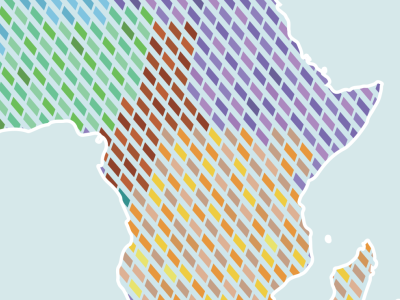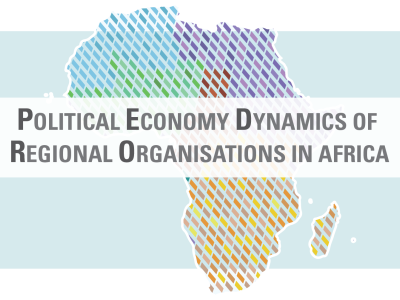
On transport corridors: People, profits, politics and patience
Corridors are becoming all the rage – as a priority for the African Continental Free Trade Area (AfCFTA) and as a focus of the recently launched EU Global Gateway. Recent research can offer a range of insights into what these actually entail.
AFRIGOS was a multi-year, multi-discipline, multi-level comparative research project looking at ports, border towns and transport corridors in Africa. Part of its ambition was to look at the growing narrative around these corridors – essentially key trade and transport routes linking ports and cities – and how this relates to the people and spaces around them.
Last week saw its closing workshop where, given our own work on regional integration and corridors and contribution to a book on transport corridors in Africa (in all good bookshops and open access soon!), ECDPM was present for two days of intensive presentations, discussions and roundtables in Stellenbosch, South Africa.
Peak ‘transport corridors’ was in 2000, but they’re back on the rise!

The research presented covered everything from an analysis of how bureaucratic shifts within the World Bank altered the use of the corridor concept in Africa (Sidy Cissokho) to the vibrant dynamics of informal cross-border markets such as Kye-Ossi in Southern Cameroon (Michel Medjo Medjo). It further included the optimisation calculations of truck drivers on the Northern corridor between sleep, time, risk and space (Hugh Lamarque) and the differing political economy and outcomes around two corridors in the same country – the Beira and Nacala corridors in Mozambique (Bruce Byiers) – and of course, discussion of the current challenges of the AfCFTA (Trudi Hartzenberg), where trade facilitation along corridors is increasingly cited as an objective.
People-centred integration?
One common thread running through most presentations was the importance of including and understanding people. Individuals, whether they be truckers, traders, customs agents or the intermediaries making a living from border inefficiencies, are the basis of everything that takes place around and along regional trade corridors. This is what could be called the ‘real regional economy’, ‘bottom-up’ regionalisation, or what former CEO of the African Union Development Agency Ibrahim Mayaki has called ‘Type II regional integration’ – Type I being the formal, top-down stuff of policymakers.
Although this calls for a more people-centred regional integration – some see the AfCFTA and other trade facilitation projects as elitist and essentially ignoring the concerns and opportunities related to ‘ordinary’ people’ (Inocent Moyo) – the truth is that policymakers often can only focus on the formal policies and agreements that are their bread and butter. That can be at the expense of ‘inclusiveness’ and context-adaptation, i.e. too much Type I without enough attention to Type II. That trade policy is not adapted to or able to capture informal or unrecorded trade goes by definition.
But the challenge then is to see how to adapt the world of formal trade agreements and processes to the real world – a challenge that is very much about avoiding the state, or using networks and relations to facilitate trade. Certain attempts have been made by regional organisations, with Simplified Trade Regimes that lower the burden on small-scale traders, and border charters laying out the rights and responsibilities of all involved actors to hold each other accountable. However, even these cannot cover the wide variation of complex interactions between individuals and the state, which invariably form a system, rather than being an anomaly.
The outcome of every border interaction depends on a whole series of motivations and interests. In a recent paper we presented the following picture to highlight the challenge of formalising trade through better information and training – the usual approach. As it shows, full compliance is really only one of a wide set of possible outcomes of each interaction.

Making corridors more ‘people-centred’ therefore makes sense, but remains a complex undertaking, best applied at a micro-level, at and around different border posts. That requires long-term, resource-intensive efforts to engage with actors at border posts and adapt approaches to where there is room and traction for change. Learning lessons from the above-mentioned Simplified Trade Regimes and border charters would be a good start.
The prominence of ‘profitable inefficiency’
The goal of trade facilitation and transport corridors is ostensibly to reduce inefficiencies at ports, borders and along transport routes. Building on the historical support of actors like the World Bank, the African Development Bank (AfDB) and the multi-donor vehicle TradeMark East Africa, the EU recently launched its Global Gateway strategy, selecting eleven African corridors that will receive funding to encourage efficiency and trade-enhancing investment.
But such support tends to ignore that inefficient systems have a history and a raison d’être – something Hugh Lamarque referred to as ‘profitable inefficiency’. The reason for this can be path dependency, but being inefficient can also mean being more inclusive – whether in terms of how freight is shared out among truckers or the livelihoods created by helping truckers navigate bureaucratic hurdles at borders, the Abidjan-Ouagadougou corridor being one example.
One presentation by Paul Nugent also discussed how border towns, such as Aflao in Ghana, are urbanising faster than their capital cities, where these are not burgeoning border cities in their own right, like Lomé on the Togo side of Aflao. Cross-border trade is therefore driving wider urban dynamics and it has not particularly to do with trade along the Abidjan-Lagos corridor, but rather trade at and around the different border posts – the places where price differentials and border inefficiencies make trade profitable for those who can navigate it.
This is not to romanticise the role of borders as barriers, but rather to place the interest in the likes of One Stop Border Posts (OSBP) in a broader context. There are numerous OSBP successes. Isabella Soi presented work on those in Uganda – but again this apparently technical solution is anything but, and has played out quite differently in different border contexts due to the varying interests and incentives of those around them. While one positive outcome can actually be the encouragement of national agencies to communicate better, OSBPs are also subject to the wider political environment – the Katuna-Gatuna border crossing between Rwanda and Uganda was closed for three years due to political tensions between their respective leaders.
Regional integration – local and national politics
The third thread running through almost all discussions was therefore the need to take account of the incentives and power relations around corridors at all levels. As well as individuals at the borders, corridor dynamics can alter domestic power relations around corridors and between states – Ellie Gambino discussed how the LAPSSET corridor in Northern Kenya had actually led to a power shift to the local level, away from the national government – or high-level political relations (the Mozambique Malawi case, or indeed Rwanda-Uganda). The rising tensions between the Democratic Republic of the Congo (DRC) and Rwanda just after DRC was accepted into the East African Community also underline the multi-layered politics at play.
The current blockages with completing AfCFTA negotiations – due to have ended on 30 June 2022 – also centre on finalising the rules of origin, where some large economies seek to sell to others while avoiding having to open up to imports. National politics and the concern for employment – and indeed the role of unions in some countries in protecting current jobs, rather than focusing on creating new jobs – clearly also have important implications for regional trade and the role transport corridors can play. In some cases, these concerns have already led to border closures, but to little effect in terms of creating investment, jobs and cheaper internal production given the wider political context.
But even where borders are not closed, the question is whether the political incentives are in place and the underlying economic demand is there, to reduce trade barriers along the Abidjan-Lagos corridor, for example. Even the port dynamics, where a few companies essentially run all the ports in the region, would seem to go against this development, a point suggested by the ports overview offered by Jonas Aryee.
Though not the primary focus of AFRIGOS research, being people-centred should also mean looking at the movement of people along and around corridors and borders. For goods to move and services to be offered also requires people to move. But given the poor momentum around the AU’s free movement protocol (which opened for signatures at the same time as the AfCFTA) and the political fears around migration and immigration, it is not clear how far this agenda will progress in the near future, meaning that people will continue to trade and move – just not in ways recognised by the state.
Optimism with patience
The British pop-philosopher Alain de Botton talks about frustration being the result of over-optimism: it is only because people optimistically imagine everything going well, all the time, that the slightest hiccup leads to frustration. The AfCFTA secretariat is putting further emphasis on corridors as a means to achieve the gains of the AfCFTA, and the EU’s Global Gateway strategy adds to that. All of the above suggests the need for patience and to think incrementally, whether about the AfCFTA or how efficiency gains are made on key transport corridors.
The views are those of the author and not necessarily those of ECDPM.






